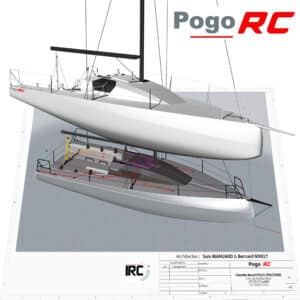
Open 6.50 368
If his living room were big enough, Jerome Sammarcelli would display an Open 6.50 (that’s “six-fifty”) like a piece of modern art, where he could admire its robust curves and autoclaved carbon beauty. But the real magnificence of the boat, he says, is better appreciated on the water, reaching along under its 516-square-foot asymmetric. Sportboat sailing should be high-performance sailing, he says, and that’s exactly what the 6.50 is-heart-racing, sweat-inducing, wet, fast, and all of that.
It’s understandable that Sammarcelli and his business partner, Nick Vale, are excited about the 6.50. As proprietors of Sailing Sportboats, in Marina del Rey, Calif., they began importing the boat from France last fall, adding it to their showroom lineup, which includes the Open 5.70 (SW’s 2007 One-Design of the Year). Like the 5.70, this boat is a pure raceboat and an exciting daysailer all in one. But, unlike the 5.70, the Open 6.50 is definitely not meant to be a strict one-design. It’s a high-speed PHRF racer.
“Its one purpose,” says Sammarcelli, “is to get on a plane and go fast.”
Designed by Groupe Finot, the 21-footer is exactly as it appears: essentially a scaled down Open 60, for which Finot is best known. It has all the “Open” attributes: heaps of stability, a lot of power in the sail plan, and yes, a good bit of wetted surface, too. It has the requisite dual rudders, a deep (6’6″) bulb keel, and a tall, 35-foot rotating carbon mast. It mostly sails upwind at 15 degrees of heel (something that takes getting used to unless you regularly sail scows), and once the breeze steps over 10 knots, the boat will most definitely plane downwind.
It may be sexy on the outside (especially to those who prefer the modern, Open style), but peek inside the watertight hatch and you really appreciate (or at least start to appreciate) the $64,650 price tag-that’s with sails. The high-quality construction is a result of Groupe Finot’s collaboration with the aerospace industry in Southern France in the development of autoclave production. Both its hull and deck are pre-preg carbon elements, cured in an autoclave. The backbone of the hull-stringers and reinforcements-is cured along with the hull to produce an incredibly lightweight and stiff one-piece structure.
With all that carbon built into the hull, why stop there? The 35-foot rig is carbon, as are the rudders, keel, boom, and the vast majority of deck fittings. When it’s all said and done, the hull alone weighs roughly 1,200 pounds. With 485 pounds in the bulb keel, you get a boat that’s guaranteed to be lively across the entire wind range, and towable behind the family hybrid.
SW’s Boat of the Year judges got their first crack at the 6.50 last fall and came away from their light-air sail with a positive impression. “The boat has an excellent groove in both directions,” says Chuck Allen. “Upwind, if you crack off ever so slightly, you take off. Just heading up a touch downwind makes all the difference.”
Barrett Holby, who is intimately familiar with this style of boat, said it was the most fun boat to sail of the entire fleet. “You just knew from looking at it from off the boat, that it was certainly the coolest boat.”
Sammarcelli himself has logged the most time in the 6.50, both in France and in Marina del Rey’s PHRF fleet. The boat’s Southern California PHRF base rating is 90, which Sammarcelli says is about right. They suffer in any light-air windward/leeward races, but toss in a reach leg, or a distance race, and the boat delivers. “It needs 8 to 10 knots to do really well,” he says.
In light air, three crewmembers can manage the boat well, but once you get to 10 knots, four 180-pounders are definitely required. One crew handles the main and the other two work the jib. The jib system is one detail the BOTY judges thought was inadequate, and Sammarcelli agrees-it’s one thing he says he would change on the boat. With only a 2-to-1 sheet, handling the 129-square-foot jib is a challenge, he says. In France, most 6.50 teams add a 4-to-1 fine-tune setup. One of the forward crew is also responsible for mast rotation through the tacks.
Jib system aside, the 6.50 is the beneficiary of several years of development in France, and the rest of the sail controls are pretty well refined. For the mainsail, there’s a cunningham, outhaul, mainsheet, and stern-mounted traveler. There is a jib cunningham, but it’s at the forestay, so it’s usually adjusted between races. The spinnaker gets launched from a bag in the cockpit. A Spectra bobstay spliced into the bow knuckle takes the loads off the sprit box. A bungee takes up the bobstay slack when the 7-foot pole is retracted.
The cockpit is 8 feet wide and extends well forward, so there’s plenty of elbowroom for four adults to get things done. Hiking is legs-in style, and high foot chocks run the length of the cockpit; these chocks are a necessity given the constant heel angle upwind. If required for offshore PHRF racing, stanchions and lifelines can be installed using threaded holes in the deck.
The second of two 6.50s now in the country will be raced in the Chesapeake, where it has been assigned a 97 PHRF rating. It will be a tough number to hit consistently, but as Sammarcelli points out: when you buy a boat like this, it’s not all about the number, it’s how much fun you have in trying to sail to it. When the small-craft pennant is flying, this is the sort of boat you’ll want to rig up and go sailing (and there are reef points in the main should conditions go beyond small-craft). It’s impossible to argue with that selling point.
Open 6.50 Specs
LOA 21’4″
LWL 21’4″
Beam 8’4″
Draft 6’6″
DSPL 1,168 lbs.
Ballast 485 lbs.
SA (u/d) 425/812 sq.ft.
Price $64,650
www.sailingsportboats.com









